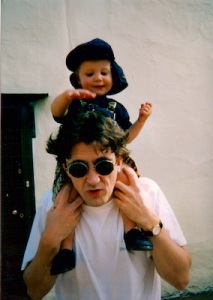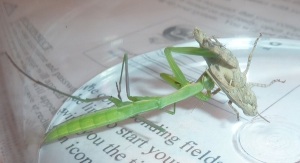He, scientist
Ed Yong has just written about a wonderful new paper published in Biology Letters, a journal of the Royal Society. It concerns the foraging behaviour of the Buff-Tailed Bumble-Bee, or Bombus terrestris. So far, so normal. Yet the study is written in rather casual language, and includes illustrations in coloured pencil. This is because the particular authors of the study are primary school children aged between 8 and 10. The paper is part of a brilliant project called ‘i, scientist’ – which aims to get people interested in science by actually doing real science, rather than just watching it, reading about it or listening to it. More info available here.
Ed’s post coincided with a nice incident at my breakfast table this morning, and got me thinking about young minds and science communication….
My son Dominic is nearly 14. For as long as I can remember, he’s been interested in life sciences. It wasn’t something that came from me, as I was more of a physics/computer/space kind of guy. And my screenwriting wife prefers the human drama of surgery. But I can always rely on my son when I want to know the name and habits of an obscure lizard or bug on TV.
This morning I came down to see a musty old second-hand book on the table. ‘Recent Advances in Entomology” by A.D. Imms. Hmm. hardly that recent. The book was published in 1937. I asked my son where it came from. He told me that he’d used some money I’d given him a few days before to browse the local antique bookshop – and had bought this tome. I was enormously touched by this. It would have been perfectly fine (and in character) for him to spend it on chewing gum or some novelty drink from a cafe. But he hadn’t. He’d been curious about science – and had used his own time and money to investigate it.
This year I’ve embarked on an MSc in Science Communication at Imperial College, London. This concerns the interface between science and the public – and how scientific knowledge can best be understood and propagated in the public sphere. But when I think about what made me choose to study this, I can’t help returning to my experiences with Dominic. Essentially, the parent of any child is a science communicator, whether they like it or not. The world is full of questions, and a child is naturally curious. To parent a child is to provide the first crucial interface between their questions and the accumulated human knowledge that can provide a meaningful answer. It is an awesome challenge and privilege. Get it right, and you can provide a human being with the starting tools they need to make sense of their own reality. Get it wrong and you might leave them confused, indifferent, ignorant, bored or – worst of all – full of their own convenient heuristics about life, which have little relationship to the facts (astrology, anyone?).
I have loved every moment of my science talks with Dom. I remember the first time I told him about atoms. Must have been no more than six. But he loved the simple beauty and symmetry of atomic structure. He particularly loved how subtle differences in weight and number could demarcate elements. And e = mc2 was a fabulously child-friendly equation to explain! It combines a very simple mass/energy relationship with the mind-boggling speed of light. And, like all good children’s shows, it ends with a very big bang (best described, rather than demonstrated). But these talks were just a taster. Little sparks that I hoped he’d use to make his own fire. You can’t make them like what you like. He won’t carry your fire. He has his own passions. You just have to hope most of it makes sense, and some of it sticks. So when your son turns up with his personal passion smelling of an old bookshop, you have to smile.
One of my favourite books about a child’s experience of science is the autobiography “Uncle Tungsten” by Oliver Sacks. Sacks’ boyhood adventures with chemistry is wonderfully told – but the young Oliver also enjoyed a surprising freedom to acquire chemical materials and test his own ideas out. And the results are now clear to the whole world. Books alone are not enough. What is so important about initiatives like ‘I, Scientist’ is the idea of communication by investigative action. Enquiry is not about a predicted outcome, like a tired old text, but something with exciting possibilities and unknowns. The energy that motivated my son to browse a bookshop can be channelled into a more proactive involvement with his world.
Last summer, we took a trip to our favourite little Tuscan spa hotel. We arrived in our hotel room tired from our journey, and I drew the curtains. There on the curtain staring back at me was a Praying Mantis. Dominic leapt into sudden life. He captured it and rushed off to find leaves and food. For the next few days he performed suitably grisly feeding experiments. The point was, he knew about mantids. He’d read about them, and seen them on T.V. But he’d never had the chance to manipulate their environment or watch their hunting habits for himself. To test new foods. To find the best container. To record the results of his efforts.
A constant complaint of science, and a persistent concern in outreach policy is that the public should not only understand the outputs of science, but also be aware of the nature of scientific practice. The scientific method. That way the public can understand what science can and cannot say about reality, and so dispel the mythologies – both positive and negative – associated with it. Yet how is this best done? By telling them about these methods, and hoping that they take these complex scientific norms on trust? Or by letting them experience it for themselves? As a humble dad I can think of no better way to give our next generation of citizens a clear grasp of the methods and possibilities of science than by letting them do real science as children, and taking them seriously when they do. Beau Lotto and the ‘i, scientist’ project are to be congratulated. A method is a way of doing, not just a way of understanding. So let them do it!

